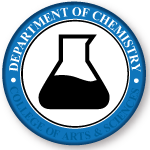Document Type
Article
Publication Date
5-2005
Publication Title
The Journal of Organic Chemistry
Volume
70
Issue
13
First Page
5103
Last Page
5110
Abstract
Single electron reduction of the 1,2,4-trioxane heterocycle of artemisinin (1) forms primary and secondary carbon-centered radicals. The complex structure of 1 does not lend itself to a satisfactory dissection of the electronic and steric effects that influence the formation and subsequent reaction of these carbon-centered free radicals. To help demarcate these effects, we characterized the reactions of achiral dispiro-1,2,4-trioxolane 4 and dispiro-1,2,4-trioxanes 5−7 with ferrous bromide and 4-oxo-TEMPO. Our results suggest a small preference for attack of Fe(II) on the nonketal peroxide oxygen atom of 1. For 4, but not for 5 and 6, there was a strong preference for attack of Fe(II) on the less hindered peroxide bond oxygen atom. The steric hindrance afforded by a spiroadamantane in a five-membered trioxolane is evidently much greater than that for a corresponding six-membered trioxane. Unlike 1, 5−7 fragment by entropically favored β-scission pathways forming relatively stable α-oxa carbon-centered radicals. These data suggest that formation of either primary or secondary carbon-centered radicals is a necessary but insufficient criterion for antimalarial activity of 1 and synthetic peroxides.
Recommended Citation
Tang, Yuanqing; Dong, Yuxiang; Wang, Xiaofang; Sriraghavan, Kamaraj; Wood, James K.; and Vennerstrom, Jonathan L., "Dispiro-1,2,4-trioxane Analogues of a Prototype Dispiro-1,2,4-trioxolane: Mechanistic Comparators for Artemisinin in the Context of Reaction Pathways with Iron(II)" (2005). Chemistry Faculty Publications. 15.
https://digitalcommons.unomaha.edu/chemfacpub/15


Comments
Copyright © 2005 American Chemical Society